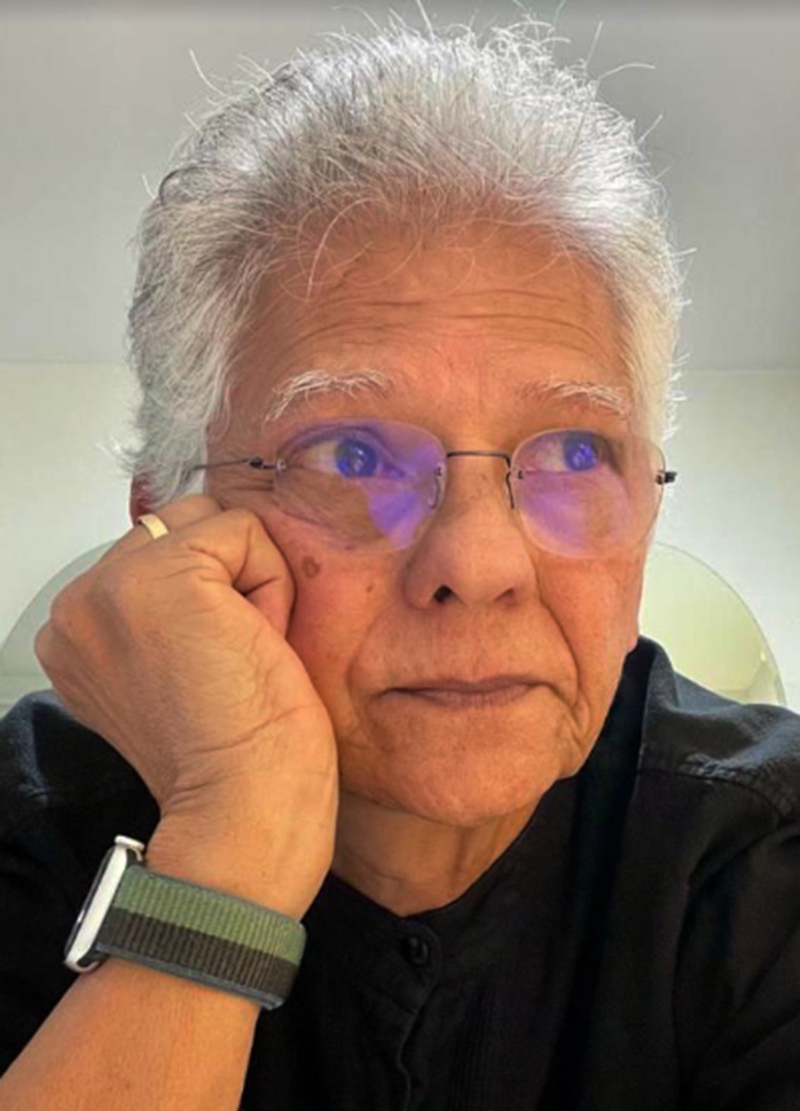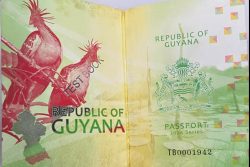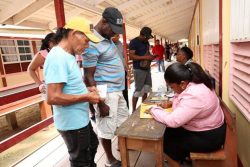 The University of Guyana and the Theatre Guild of Guyana are currently collaborating in the production of a programme of two plays – The Tramping Man by Ian McDonald and Duenne by Paloma Mohamed, currently running at the Theatre Guild Playhouse in Kingston until April 22. Both dramatic works are unforgettable experiences in theatre directed by distinguished designer and director Henry Muttoo, the presently serving Artist in Residence at the University of Guyana.
The University of Guyana and the Theatre Guild of Guyana are currently collaborating in the production of a programme of two plays – The Tramping Man by Ian McDonald and Duenne by Paloma Mohamed, currently running at the Theatre Guild Playhouse in Kingston until April 22. Both dramatic works are unforgettable experiences in theatre directed by distinguished designer and director Henry Muttoo, the presently serving Artist in Residence at the University of Guyana.
The occasion brings together two legendary institutions, among the most important in the country and the Caribbean region, and an icon in the theatre, who is among the most acclaimed and respected practitioners in both country and region, to produce exceptionally important artistic output on the local stage.
The UG holds an extraordinary place as the national university and one of the independent colleges in the Anglophone region. Like so many establishments of higher learning, it has a deep and noble association with the arts, including a history of literature, music, dramatic productions and art exhibitions and a very old Artist in Residence programme. This was firmly established when Martin Carter held the first Residency in the late 1970s, followed by his appointment as Senior Fellow when that ended. After a long hiatus Residencies resumed in 2017 with musicians – Keith Waithe followed by Dave Martins.
The Theatre Guild, a continuing amateur foundation, was founded in 1957 and quickly rose to be Guyana’s most significant theatre house and training accommodation. It previously offered initial practice, workshops, stage experience and scholarships which have produced some of the most outstanding theatre personalities in the Caribbean, one of whom is Henry Muttoo.
Muttoo brings UG, the Theatre Guild and two of Guyana’s important plays together in this current production. He is among the most respected theatre artists in the Caribbean, starting with apprenticeship at the Guild in the 1970s entry into professional performance as a member of the extraordinary All Ah We stage group. His illustrious career continued with service at the Jamaica School of Drama and Artistic Director of the Cayman National Cultural Foundation. He studied at the famous Rose Bruford College of Theatre and Performance and other institutions, rising to be the Caribbean’s leading expert on stage design. He worked with the region’s top dramatists, including Walcott, and accomplished a series of outstanding productions as director/designer. Duenne and Tramping Man are his most recent stage works and his first return visit to his native Guyana.
Ian McDonald’s Tramping Man (1966) established itself as one of Guyana’s foundation plays, emerging not only in the year of Independence, but at the time when modern Guyanese drama was rising and taking shape. It has not lost that importance from its first impact at the Guild Playhouse directed by Ken Corsbie with Marc Matthews as the tramping man. McDonald is an established poet, novelist, non-fiction writer, editor, anthologist, columnist and playwright, who has multiple Guyana Prize Awards for Poetry and a most recent prize in the new Non-Fiction category. He, also, is highly respected in the Caribbean, and his one known play was published in the Carifesta anthology A Time and A Season (1976) edited by Errol Hill.
That publication selected it among momentous West Indian dramas with a place in the advancement of the theatre, alongside Rodrick Walcott’s The Banjo Man. Muttoo identifies McDonald’s play in that company, recognising that “it remains as relevant today as it was when. . . first powerfully portrayed (as a) remembrance of the beauty of life and the necessity for a freedom that exacts no payment but the acknowledgement that we are the freedom and beauty we seek”. It is a similar portrayal that Walcott affords the banjo man in the play he alternatively called “Chanson La Rose” (song of the La Rose festival) in which the banjo man with his traditional music mesmerises and leads St Lucians in the carnivalesque trampings on the streets of Castries.
Muttoo’s interrogating production clarifies his interpretation of McDonald’s meaning in a deep and probing celebration of life and the freedom to express it in a colonial setting where there is a tendency to control and prune everything; where there is the conservative temptation to regard unbridled enjoyment as sin. It is a struggle between power and free expression in which the police on behalf of the colonial powers fail to rein in what they saw as a touch of madness but in which they could find no crime. The play leaves them powerless against the mystery of a man who had the ability to hypnotise all, from government and church officials to the regular people of Georgetown.
In the play the Police Commissioner (Colleen Humphrey) and government officials (Mark Luke-Edwards and Sheron Cadogan Taylor) under orders from the Minister, seek to rein in a new craze that hits the town as a seemingly highly inspired reveler (Keon Heywood) is leading virtually the whole population on a wild carnival tramp around the city. None can resist him and the authorities seem afraid he might become a threat to stability and multitudes of happy people make them apprehensive. The tramping man is arrested and imprisoned while police officer Kassim (Paul Budnah) assisted by a warden (Jennifer Kendall) struggles to find witnesses (Joshua Macey and Sonia Yarde) to build a case to incriminate him.
The play resonates with allusions from the Greek Euripides to “The Pied Piper of Hamlin”. In Euripides’ The Bacchae the king has a similar problem when a strange man appears in the city leading scores of women on a wild inebriated tramp through the city. The king tries to imprison him, not aware that it is the god Bacchus (Dionysus) and the revels are according to his worship. In the well known long poem, the dishonest officials of the town of Hamlin try to cheat the Piper, but prove no match for his mysterious power to enchant.
Muttoo plays this out with interactive action close to and within the audience against an architecturally striking set. The symbol of imprisonment stands out within a structure that is a work of art. Both Luke-Edwards and Cadogan-Taylor who performed out of the fourth wall were convincing and maneuvered well between the audience and the aisles with convincing civil service types, but surprisingly, the acoustics in the auditorium were less than ideal for them. Although fairly restricted in the prison cell, Keon Heywood explored the unencumbered mind of the tramping man with his spirit of the free country-side and slightly veiled mysticism. He succeeded in playing the undefeated commitment to a freedom of the soul. On the other hand Budnah understands the determined and single-minded pursuit of the police, with a believable performance of a faithful servant.
Mohamed’s Duenne (1998) is another of the important plays in Guyanese Drama, and this is undeniably demonstrated in this production by Muttoo. It won the 1998 Guyana Prize for Drama and was published by the Caribbean Press many years later in addition to a number of stage performances through the years. It rates as Mohamed’s best play to date, high in artistic accomplishment to add to a number of successes in the popular theatre and other Guyana Prize Awards, to make her an extraordinarily decorated national dramatist. She is further distinguished as one of only a few West Indian dramatists with a published collection of plays (Walcott, Rhone, Gibbons, Lovelace, Matura, Edgcomb).
Now playing at the Guild Playhouse, this is without doubt the best production of Duenne ever produced. It already has the advantage of being a multi-layered drama open to interpretations, and Muttoo not only gives it clarity, but a director’s interpretation that is rich in philosophical thought as it is exceptionally spectacular in stagecraft, colourful and commanding in performance. It is a triumph for the actors as it is for the director and for Guyanese theatre.
At the very basic level, the play is pro-choice in a modern world still debating abortion, its trauma and its necessity. But it is psychological theatre, highly existentialist and post-modern, if not feminist. It argues a justifiable case for abortion but is neither so simple nor one-dimensioned as it explores the mind of both woman and artist, creation, creativity, the imagination, the existence and the personality of a God. A physically appealing artist Madonna (Sonia Yarde), is caught in a panic when her lover, in whom she has found both physical and spiritual fulfillment, suddenly leaves her. She is devastated and inspirationally barren, but physically fertile as she discovers that she is pregnant. The idea horrifies her and she struggles with it as she cannot paint, cannot earn, and is materially and emotionally unprepared.
The character named “IT” is God (Frederick Minty), resident in a nether world, the supreme creator waiting with Aisha (Lateifa Agard), the child expecting to be born. Muttoo puts it eloquently: “The pawn in the struggle is Aisha, IT’s masterpiece of art seeded in the purgatory of Madonna’s womb/imagination”. Because the play’s director sees both IT and Aisha and the interplay between them as existing entirely in Madonna’s mind/imagination. He sees the play trying to unravel “the tangled mystery of creation – its origin and purpose – and mankind’s attempts to find answers, which have thrown the characters into . . . an incessant merciless struggle between SPIRIT and FLESH”.
And surely in this production there is that tension between flesh and spirit. It is a Creation story, interpreting the Biblical images of God creating life. On one level, IT is an artist who creates Madonna, is overcome by her beauty, becomes her lover, and Aisha is created. It alludes to Greek mythology and the sculptor Pygmalion who falls in love with his own statue of the perfect woman.
Minty plays to form. An actor often cast in farce and comic play comes to life in a classically polished role which exhibits genuine talent and the ability to study. As a graduate of the National School of Drama and member of the National Drama Company, that would not be strange to him. Minty is at home and convincing as the God figure, as the artist and as a lover. He transitions and navigates around all facets of his role without confusing an audience, but rather succeeds in delighting them.
His precise performance demonstrates an understanding of the play and the director’s concept.
Minty interprets the clear notion that mankind is given the power to choose and as “God”, imparts this to Aisha with whom he interacts as father and daughter. That is the interplay fed to the audience by Agard who also gives a startlingly clear and confident interpretation of the role in her outstanding acting. She can switch seamlessly from the slightly spiritual to the precocious or pesky child. She swerves acrobatically from relations with IT to the imagined interactions with Madonna which really do not exist. All told, Agard is a definite and valuable discovery to the stage.
The name, Madonna, itself has resonances. It came into use in 1584 in the Renaissance as old Italian for Lady or “my lady”, but soon became a reference to artistic representations of the Virgin Mary or Mary herself. In this play there is that ironic representation of a Madonna representing beauty, purity and chastity, but also a contrasting image of sensuality, as Madonna is in this play. Yarde plays this exquisitely. It is a very welcome return to complete and fulfilling roles such as these played by Yarde. She recently had that opportunity just two months ago as the prostitute Meri in the play Sauda, performed by the National Drama Company for the Guyana Prize Literary Festival. Yarde is a member of that Company. She seizes the chance again here as the sexy creative artist in a UG and Theatre Guild production.
Such roles are actresses’ dreams and Yarde does not waste them. Duenne belongs to her. As the forsaken lover she chooses the right nuances, as she does for the frustrated painter confronting an empty canvass. In all Madonna’s dimensions Yarde is never less than believable. The word “duenne” derives from folklore – “douenne”, a Trinidadian spirit of a child who dies at birth and never did quite manage to get born, but returns as a malevolent spirit whose feet are turned backwards, leaving tracks on the forest floor to deceive, mislead and lose away. This is a further derivation from a West African spirit of the dead.
Yarde occupies the same space as the sexy artist as she does as the frustrated woman with the spirit of the douenne a burden on her back. Despite curiously designed and unattractive costuming, the acting is credible and an audience can understand the character. Here is a studious, sensitive all round performance that communicates meaning and entertains. It is a memorable exhibition of excellence.
This drama plays around with the Christian story of creation, but Muttoo’s imagery, design and interpretation appears particularly Christian, more specifically Roman Catholic, given the rituals and symbols employed. Very definitive is the death ritual at the end, which threatens to lend some slight suggestion of a possible judgemental interpretation to the resolution of the play .
Muttoo makes the best use of the stage. It has been a very long time since the Playhouse has been transformed into theatre-in-the-round and this is a reminder that the stage can be converted this way. This production of The Tramping Man and Duenne is a masterclass of stage artistry and gives an audience a theatrical experience that is entertaining and instructive.










